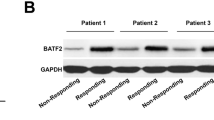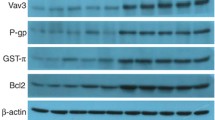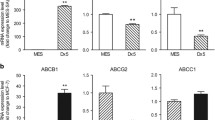Abstract
Multidrug resistance (MDR) remains a major clinical obstacle in the treatment of gastric cancer (GC) since it causes tumor recurrence and metastasis. The transcription factor activator protein-2α (AP-2α) has been implicated in drug-resistance in breast cancer; however, its effects on MDR of gastric cancer are far from understood. In this study, we aimed to explore the effects of AP-2α on the MDR in gastric cancer cells selected by vincristine (VCR). Decreased AP-2α levels were markedly detected by RT-PCR and Western blot in gastric cancer cell lines (BGC-823, SGC-7901, AGS, MKN-45) compared with that in the gastric epithelial cell line (GES-1). Furthermore, we found that the expression of AP-2α in SGC7901/VCR or SGC7901/adriamycin (ADR) cells was lower than in SGC7901 cells. Thus, a vector overexpressing AP-2α was constructed and used to perform AP-2α gain-of-function studies in SGC7901/VCR cells. The decreased IC50 values of the anti-cancer drugs in sensitive and resistant cells after transfect with pcDNA3.1/AP-2α were determined in SGC7901/VCR cells by MTT assay. Moreover, flow cytometry analysis indicated that overexpressed AP-2α induced cell cycle arrest in the G0/G1 phase and promoted cell apoptosis of VCR-selected SGC7901/VCR cells. RT-PCR and Western blot demonstrated that overexpressed AP-2α can significantly induce the down-regulation of Notch1, Hes-1, P-gp and MRP1 in SGC7901/VCR cells. Similar effects can be observed when Numb (Notch inhibitor) was introduced. In addition, the intracellular ADR accumulation was markedly detected in AP-2α overexpressed or Numb cells. In conclusion, our results indicate that AP-2α can reverse the MDR of gastric cancer cells, which may be realized by inhibiting the Notch signaling pathway.




Similar content being viewed by others
References
Jemal A, Bray F, Center MM, Ferlay J, Ward E, Forman D (2011) Global cancer statistics. CA Cancer J Clin 61:69–90. doi:10.3322/caac.20107
Teodori E, Dei S, Martelli C, Scapecchi S, Gualtieri F (2006) The functions and structure of ABC transporters: implications for the design of new inhibitors of Pgp and MRP1 to control multidrug resistance (MDR). Curr Drug Targets 7:893–909
Zhang D, Fan D (2010) New insights into the mechanisms of gastric cancer multidrug resistance and future perspectives. Future Oncol 6:527–537. doi:10.2217/fon.10.21
Noguchi K, Katayama K, Sugimoto Y. (2014) Human ABC transporter ABCG2/BCRP expression in chemoresistance: basic and clinical perspectives for molecular cancer therapeutics. Pharmgenom Pers Med 7:53–64. doi:10.2147/PGPM.S38295
Hong L, Piao Y, Han Y et al (2005) Zinc ribbon domain-containing 1 (ZNRD1) mediates multidrug resistance of leukemia cells through regulation of P-glycoprotein and Bcl-2. Mol Cancer Ther 4:1936–1942. doi:10.1158/1535-7163.MCT-05-0182
Huang S, Chen M, Shen Y et al (2012) Inhibition of activated Stat3 reverses drug resistance to chemotherapeutic agents in gastric cancer cells. Cancer Lett 315:198–205. doi:10.1016/j.canlet.2011.10.011
Zhu W, Xu H, Zhu D et al (2012) miR-200bc/429 cluster modulates multidrug resistance of human cancer cell lines by targeting BCL2 and XIAP. Cancer Chemother Pharmacol 69:723–731. doi:10.1007/s00280-011-1752-3
Karjalainen JM, Kellokoski JK, Eskelinen MJ, Alhava EM, Kosma VM (1998) Downregulation of transcription factor AP-2 predicts poor survival in stage I cutaneous malignant melanoma. J Clin Oncol 16:3584–3591
Motley AM, Berg N, Taylor MJ et al (2006) Functional analysis of AP-2 alpha and mu2 subunits. Mol Biol Cell 17:5298–5308. doi:10.1091/mbc.E06-05-0452
Eckert D, Buhl S, Weber S, Jager R, Schorle H (2005) The AP-2 family of transcription factors. Genome Biol 6:246. doi:10.1186/gb-2005-6-13-246
Pellikainen JM, Kosma VM (2007) Activator protein-2 in carcinogenesis with a special reference to breast cancer—a mini review. Int J Cancer 120:2061–2067. doi:10.1002/ijc.22648
Wang W, Lv L, Pan K et al (2011) Reduced expression of transcription factor AP-2alpha is associated with gastric adenocarcinoma prognosis. PLoS ONE 6:e24897. doi:10.1371/journal.pone.0024897
Li C, Guo D, Tang B, Zhang Y, Zhang K, Nie L. (2016) Notch1 is associated with the multidrug resistance of hypoxic osteosarcoma by regulating MRP1 gene expression. Neoplasma. doi:10.4149/neo_2016_510
Radtke F, Raj K (2003) The role of Notch in tumorigenesis: oncogene or tumour suppressor? Nat Rev Cancer 3:756–767. doi:10.1038/nrc1186
Stoyanova T, Riedinger M, Lin S et al (2016) Activation of Notch1 synergizes with multiple pathways in promoting castration-resistant prostate cancer. Proc Natl Acad Sci USA 113:E6457–E6466. doi:10.1073/pnas.1614529113
Sun L, Liu M, Sun GC et al (2016) Notch signaling activation in cervical cancer cells induces cell growth arrest with the involvement of the nuclear receptor NR4A2. J Cancer 7:1388–1395. doi:10.7150/jca.15274
Wael H, Yoshida R, Kudoh S, Hasegawa K, Niimori-Kita K, Ito T (2014) Notch1 signaling controls cell proliferation, apoptosis and differentiation in lung carcinoma. Lung Cancer 85:131–140. doi:10.1016/j.lungcan.2014.05.001
Osipo C, Patel P, Rizzo P et al (2008) ErbB-2 inhibition activates Notch-1 and sensitizes breast cancer cells to a gamma-secretase inhibitor. Oncogene 27:5019–5032. doi:10.1038/onc.2008]
Zou W, Ma X, Hua W, Chen B, Cai G (2015) Caveolin-1 mediates chemoresistance in cisplatin-resistant ovarian cancer cells by targeting apoptosis through the Notch-1/Akt/NF-kappaB pathway. Oncol Rep 34:3256–3263. doi:10.3892/or.2015.4320
Kim B, Stephen SL, Hanby AM et al (2015) Chemotherapy induces Notch1-dependent MRP1 up-regulation, inhibition of which sensitizes breast cancer cells to chemotherapy. BMC Cancer 15:634. doi:10.1186/s12885-015-1625-y
Kantarci H, Edlund RK, Groves AK, Riley BB (2015) Tfap2a promotes specification and maturation of neurons in the inner ear through modulation of Bmp, Fgf and notch signaling. PLoS Genet 11:e1005037. doi:10.1371/journal.pgen.1005037
Chen Z, Zhang L, Xia L et al (2014) Genomic analysis of drug resistant gastric cancer cell lines by combining mRNA and microRNA expression profiling. Cancer Lett 350:43–51. doi:10.1016/j.canlet.2014.04.010
Zhang XF, Pan QZ, Pan K et al (2016) Expression and prognostic role of ubiquitination factor E4B in primary hepatocellular carcinoma. Mol Carcinog 55:64–76. doi:10.1002/mc.22259
Schmittgen TD, Livak KJ (2008) Analyzing real-time PCR data by the comparative C(T) method. Nat Protoc 3:1101–1108
Wang Y, Liu L, Liu X et al (2013) Shugoshin1 enhances multidrug resistance of gastric cancer cells by regulating MRP1, Bcl-2, and Bax genes. Tumour Biol 34:2205–2214. doi:10.1007/s13277-013-0758-3
Hong L, Wang J, Han Y et al (2007) Reversal of multidrug resistance of vincristine-resistant gastric adenocarcinoma cells through up-regulation of DARPP-32. Cell Biol Int 31:1010–1015. doi:10.1016/j.cellbi.2007.03.020
Yuan CH, Horng CT, Lee CF et al (2016) Epigallocatechin gallate sensitizes cisplatin-resistant oral cancer CAR cell apoptosis and autophagy through stimulating AKT/STAT3 pathway and suppressing multidrug resistance 1 signaling. Environ Toxicol. doi:10.1002/tox.22284
Li D, Zhou L, Huang J, Xiao X. (2016) Effect of multidrug resistance 1/P-glycoprotein on the hypoxia-induced multidrug resistance of human laryngeal cancer cells. Oncol Lett 12:1569–1574. doi:10.3892/ol.2016.4749
Zhang Y, Wang Q (2013) Sunitinib reverse multidrug resistance in gastric cancer cells by modulating Stat3 and inhibiting P-gp function. Cell Biochem Biophys 67:575–581. doi:10.1007/s12013-013-9544-5
Zhang J, Brewer S, Huang J, Williams T (2003) Overexpression of transcription factor AP-2alpha suppresses mammary gland growth and morphogenesis. Dev Biol 256:127–145
Wajapeyee N, Raut CG, Somasundaram K (2005) Activator protein 2alpha status determines the chemosensitivity of cancer cells: implications in cancer chemotherapy. Cancer Res 65:8628–8634. doi:10.1158/0008-5472.CAN-05-1059
Ebert MP, Tanzer M, Balluff B et al (2012) TFAP2E-DKK4 and chemoresistance in colorectal cancer. N Engl J Med 366:44–53. doi:10.1056/NEJMoa1009473
Wajapeyee N, Somasundaram K (2003) Cell cycle arrest and apoptosis induction by activator protein 2alpha (AP-2alpha) and the role of p53 and p21WAF1/CIP1 in AP-2alpha-mediated growth inhibition. J Biol Chem 278:52093–52101. doi:10.1074/jbc.M305624200
Choudhuri S, Klaassen CD (2006) Structure, function, expression, genomic organization, and single nucleotide polymorphisms of human ABCB1 (MDR1), ABCC (MRP), and ABCG2 (BCRP) efflux transporters. Int J Toxicol 25:231–259. doi:10.1080/10915810600746023
Choi CH. (2005) ABC transporters as multidrug resistance mechanisms and the development of chemosensitizers for their reversal. Cancer Cell Int 5:30. doi:10.1186/1475-2867-5-30
Szakacs G, Paterson JK, Ludwig JA, Booth-Genthe C, Gottesman MM (2006) Targeting multidrug resistance in cancer. Nat Rev Drug Discov 5:219–234. doi:10.1038/nrd1984
Louisa M, Soediro TM, Suyatna FD (2014) In vitro modulation of P-glycoprotein, MRP-1 and BCRP expression by mangiferin in doxorubicin-treated MCF-7 cells. Asian Pac J Cancer Prev 15:1639–1642
Chen YL, Yang TY, Chen KC, Wu CL, Hsu SL, Hsueh CM. (2016) Hypoxia can impair doxorubicin resistance of non-small cell lung cancer cells by inhibiting MRP1 and P-gp expression and boosting the chemosensitizing effects of MRP1 and P-gp blockers. Cell Oncol (Dordr). doi:10.1007/s13402-016-0285-5
Wang S, Lei T, Zhang M (2016) the reversal effect and its mechanisms of tetramethylpyrazine on multidrug resistance in human bladder cancer. PLoS ONE 11:e0157759. doi:10.1371/journal.pone.0157759
Author information
Authors and Affiliations
Corresponding author
Ethics declarations
Conflict of interest
The authors declare no conflicts of interest.
Rights and permissions
About this article
Cite this article
Lian, W., Zhang, L., Yang, L. et al. AP-2α reverses vincristine-induced multidrug resistance of SGC7901 gastric cancer cells by inhibiting the Notch pathway. Apoptosis 22, 933–941 (2017). https://doi.org/10.1007/s10495-017-1379-x
Published:
Issue Date:
DOI: https://doi.org/10.1007/s10495-017-1379-x




